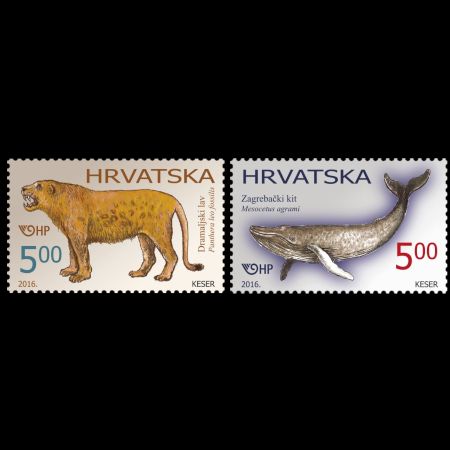Croatia 2016 "Paleontology"
| <prev | back to index | next> |
| Issue Date | 12.10.2016 |
| ID | Michel: 1246-1247,
Scott: 1009a-1009b, Stanley Gibbons: 1313-1314, Yvert et Tellier: Category: pF |
| Design | latko Keser, painter, Academy of Fine Arts, Zagreb |
| Stamps in set | 2 |
| Value | HRK 5 - The Whale of Zagreb (Mesocetus agrami) HRK 5 - The Lion of Dramalj (Panthera leo fossilis) |
| Emission/Type | commemorative |
| Places of issue | Zagreb |
| Size (width x height) | 48,28mm x 29,82mm |
| Layout | Sheet of 8 stamp each (2x4) |
| Products | FDC x1 |
| Paper | white 102 g |
| Perforation | 14 |
| Print Technique | Offset, multicolor |
| Printed by | Zrinski d.d., Čakovec |
| Quantity | 100.000 each |
| Issuing Authority | Croatian Post Inc |

On October 12, 2016, Croatian Post and Telecommunications issued the set of two commemorative stamps, shows two prehistoric animals found in this country.
THE WHALE OF ZAGREB (Mesocetus agrami, VAN BENEDEN, 1886)
 |
| The Whale of Zagreb, Mesocetus agrami on stamp of Croatia 2016, MiNr.: 1246, Scott: 1009b. |
The fossil remains of the whale of Zagreb have been found in marls of the Podsused
quarry which date from the Sarmatian, about 13 million years ago.
The remains of the whale which were lying in the depot of then National Museum were sent by
Gjuro Pilar to the Professor Pierre-Joseph van
Beneden (1809 – 1894) – Belgian zoologist and palaeontologist, for determination.
These were the bones of the back part of skull, various vertebrae, a part of jaw and auditory system and rib
fragments – in total 11 bones.
In his work “Une baleine fossil de Croatie, appartenant au genre Mesocete” from 1884 Van Beneden
attributed these bones to the remains of the whale from the genus Mesocetus and since at that time it
was an unknown species he named it after Zagreb - Mesocetus agrami.
So the whale got his name which in translation means Mesocet of Zagreb or "the Whale of Zagreb".
Some time later Dragutin Gorjanović-Kramberger,
a famous Croatian palaeontologist published his work
"O fosilnih cetaceih Hrvatske i Kranjske"
("On Fossil Cetaceans of Croatia and Carniola"), 1892 in which he described all then known
paleontological sites of whales in
Croatia and
Slovenia.
He described again the species Mesocetus agrami since from the time of Van Beneden's description
some new bones had been found which Gorjanović attributed to that same exemplar – the right upper arm bone,
a part of the lower arm bone and the lower and upper jaw.
The whale of Zagreb, Mesocetus agrami, belongs to the extinguished genus of whales - Mesocetus,
to the family of Balaenopteridae, suborder Mysticeti – Baleen whales (whalebone whales).
Today's whales from this family are among the biggest animals on Earth and some can reach the length of
up to about thirty metres.
On the basis of fossil remains – back part of the skull, upper jaw, incomplete lower jaw, right upper arm
bone, part of the right lower arm bone and thirteen vertebrae it was concluded that the whale of Zagreb was
about 6 metres long, which suggests that we are dealing here with a younger animal.
According to the structure of jaw it can be determined that the
whale most probably fed on plankton and small fishes.
THE LION OF DRAMALJ - Panthera leo fossilis (REICHENAU, 1906)
 |
| The Lion of Dramalj - Panthera leo fossilis on stamp of Croatia 2016, MiNr.: 1247, Scott: 1009a. |
In the cave Vrtare male near Dramalj at the depth of about thirty metres, rich material has been extracted
and collected from the cave sediment, consisting of fossil bones.
Collected fossil remains relate to Pleistocene fauna of big mammals from the family
Canidae, Ursidae, Felidae, Hyaenidae, Leporidae, Suidae, Cervidae, Bovidae,
Rhinocerotidae, Equidae and Elephantidae.
Among numerous and very well preserved bones prominent are the fossil remains of lions and bears.
The particularity of this paleontological site is the fossil remains of cave lions, an extinguished
species which lived in Europe and Asia during Middle Pleistocene.
The material examined so far refers to fossil bones of three grown-up males and one female.
Morphometric characteristics of teeth and other skeleton elements classify the lions
of Dramalj into the Middle Pleistocene subspecies Panthera leo fossilis.
With the body length of more than 240cm, which is 50cm more than the length of
today's African lions, this subspecies represents the biggest cat that has ever lived
on the territories of Europe and Asia.
The lions of Dramalj are among the biggest ever found fossils of European lions.
The confirmation of the Middle Pleistocene age is the result of the absolute dating
method with uranium isotopes applied on the sample of fossil lion bone, with the preliminary
age result of about 300,000 years.
It is supposed that the cave Vrtare male represents only remains from the once much vaster
speleological object whose entrance at the time of Middle Pleistocene probably functioned as
a natural trap into which the animals were caught and died, to which fact the huge accumulation
of very well preserved fossil bones is due.
The cave Vrtare male is an exceptionally valuable palaeontological site, actually the most
important one as concerns Middle Pleistocene mammals in Croatia.
Products and associated philatelic items
| FDC (clean and circulated) | ||
 |
 |
 |
| Stamp Sheets | First-Day-of-Issue Postmark | Example of circulated covers |
 |
 |
 |

|
- Technical details and short description of the stamps:
Croatian Post (English text is short, Croatian text is more detailed), Colnect,
Acknowledgements:
Many thanks to Dr. Peter Voice, PhD Department of Geological and Environmental Sciences, Western Michigan University, USA, for his help in finding information and for review of a draft of this article.
| <prev | back to index | next> |